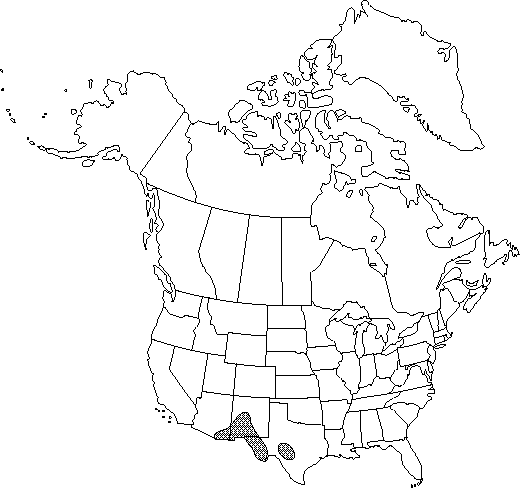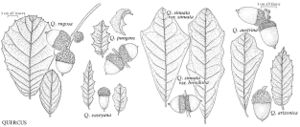Quercus pungens
Overs. Kongel. Danske Vidensk. Selsk. Forh. Medlemmers Arbeider 1854: 171. 185.
not Q. pungens Gandoger 1890.
Shrubs or moderate-sized trees, evergreen or subevergreen. Bark light-brown, papery. Twigs gray, 1-2 mm diam., short velvety-tomentose, glabrate with age. Buds dark redbrown, ca. 2 mm, sparsely pubescent. Leaves: petiole to 10 mm. Leaf-blade elliptic to oblong, 10-40 (-90) × 10-20 (-40) mm, rather thick, leathery, stiff, base rounded or minutely cordate, very rarely cuneate, margins regularly undulate-crisped, not revolute, coarsely toothed or incised with acute teeth or spinose lobes, secondary-veins 5-8 (-14) on each side, usually branched before passing into teeth, apex acute or obtuse, rarely rounded, spine-tipped; surfaces abaxially canescent, usually densely stellate-pubescent, and mixed with stiff, harsh, stellate hairs, often sandpapery to touch, rarely glabrate, adaxially yellowish green, glossy, usually rough and sandpapery because of minute, persistent hair-bases, rarely glabrate. Acorns subsessile or on peduncle to 3 mm; cup shallowly to deeply cupshaped or turbinate, to 8 mm deep × 13 mm wide, covering ca. 1/4 nut, margin thin, scales reddish-brown, moderately tuberculate or keeled, densely gray-tomentose; nut light-brown, broadly ovoid to subcylindric, to 10 × 10 mm, apex rounded to subacute, glabrous. Cotyledons distinct.
Phenology: Flowering spring.
Habitat: On dry limestone or igneous slopes, usually in oak, pinyon, and juniper woodlands, chaparral, and sometimes descending into desert vegetation
Elevation: 800-2000 m
Distribution

Ariz., N.Mex., Tex., Mexico (Chihuahua and Coahuila)
Discussion
Numerous populations appear to be hybrid swarms between Quercus pungens and Q. vaseyana, which is sometimes treated as a variety of Q. pungens. No other evidence for a close relationship exists for these two species, and such a treatment risks erecting a polyphyletic assemblage. To the west and south within the range of Q. pungens no indication of introgression exists, and the two species are strikingly different and easily separable. I interpret the contact as secondary.
Selected References
None.
